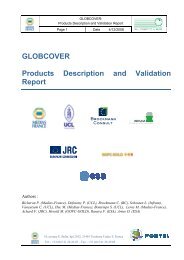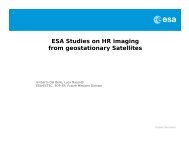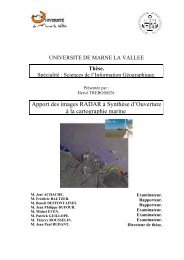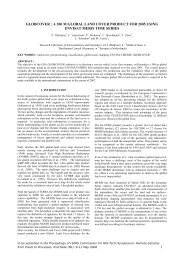Medspiration â System Requirements Document - Data User Element
Medspiration â System Requirements Document - Data User Element
Medspiration â System Requirements Document - Data User Element
Create successful ePaper yourself
Turn your PDF publications into a flip-book with our unique Google optimized e-Paper software.
<strong>Medspiration</strong> MED-SOC-RS-001_1<br />
<strong>System</strong> <strong>Requirements</strong> <strong>Document</strong> Issue F<br />
Page Table, fig. Reference ID Text from reference documents<br />
SR entry<br />
together to provide new SST data products that capitalise on their synergy, a bias and rms. error estimate is required for<br />
each [pixel] measurement. This is a fundamental component of the GHRSST-PP processing model.<br />
6 4 URD-014 Error estimates for each L2 SST measurement are based on the statistical analysis of a match up database (MDB)<br />
NASR<br />
containing satellite and in situ observations.<br />
6 5 URD-015 A quantitative confidence value is derived that is then used to assign statistical bias and rms. Error estimate to each<br />
NASR<br />
measurement.<br />
6 7 URD-016 The outputs of this process are L2 pre-processed (L2P) products for each data file ingested by the processor. NASR<br />
6 8 URD-017 Operational users that have requested [RD-13] these sparse grid SST data products may access L2P data products<br />
NASR<br />
directly in real time.<br />
6 URD-018 However, the majority of SST data users request [RD-13] complete SST fields, free of gaps caused by clouds, rain or lack<br />
NASR<br />
of data coverage, at regular intervals of between 6 and 24 hours.<br />
6 URD-019 Some require an estimate of the sub-surface SST field that cannot be directly measured using current satellite techniques NASR<br />
6 URD-020 whereas others require an estimate of the surface skin temperature that is in direct contact with the overlying atmosphere<br />
NASR<br />
and subject to considerable diurnal variability.<br />
6 URD-021 To address these needs, L2P data are used in an optimal interpolation scheme (e.g., Reynolds and Smith, 1994; Reynolds<br />
NASR<br />
et al, 2002; Guan and Kawamura, 2003) that is designed to<br />
6 URD-022 (a) account for differences in spatial and temporal sampling characteristics of each data stream, NASR<br />
6 URD-023 (b) account for gaps in coverage due to the presence of cloud, rain or lack of data, NASR<br />
6 URD-024 (c) account for SST diurnal variability and retrieve an estimate of the subsurface temperature field (referred to as the<br />
NASR<br />
foundation temperature, SSTfnd2),<br />
6 URD-025 (d) derive a measure of diurnal variability to accompany the SSTfnd estimate and NASR<br />
6 URD-026 (e) retrieve an estimate of the skin temperature of the ocean (SSTskin). NASR<br />
© 2004 SOC Page 100 of 193








